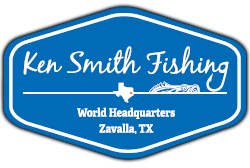Reservoir Stratification, Thermoclines, and Turnover
Posted by admin on January 5, 2022

By Todd Driscoll
Texas Parks and Wildlife Department
Most anglers have likely heard the words "thermocline" and "turnover" associated with local fishing reports and dock talk at tackle shops. Both result from thermal stratification, which is an annual occurrence at a majority of southern reservoirs. As part of the stratification process, reservoirs develop pronounced temperature barriers (thermoclines) and anoxic zones (water without oxygen) in the summer and “turnover” or mix during the fall. Many bait fish and sport fish relate to the thermocline during summer, as it contains the coldest water with adequate oxygen levels. Anglers can put more fish in the boat by better understanding the predictable process of stratification.
Thermal stratification is a direct response to the unique relationship of water density and temperature. The maximum density of water occurs at 39°F. As water cools below this temperature, it becomes lighter. Have you ever wondered why ice floats instead of sinks? Obviously, ice is the solid form of water, but it floats instead of sinking because ice is less dense than water. However, in this part of the country, water temperatures in our reservoirs seldom fall below 45°F, so to simplify, water becomes less dense as it warms. This is an important point relative to the rest of the discussion of thermal stratification.
During the spring season, the first several feet of water begin to warm. Due to the density relationship described above, this warm water layer floats, as it is less dense than the cooler water below. However, at this time this thin surface layer of warm water is subject to mixing from wind and wave action. As spring progresses into summer, the surface waters begin to warm faster and this warm water layer expands into deeper water. As this process continues to accelerate into June, the reservoir becomes stratified into three layers: 1) the upper layer of warm, less dense water of similar temperature, 2) the thermocline (small middle layer where the temperature cools dramatically between the upper and lower layers), and 3) the lower layer of colder, more dense water below the thermocline (usually has no oxygen). At Sam Rayburn and Toledo Bend reservoirs, the thermocline will typically begin to form at a water depth of 25 feet and can increase in depth to approximately 40 feet at mid-summer.
Once thermal stratification develops, the top water layer does not mix with the lower layer due to the strong water density/temperature barrier at the thermocline – it literally functions as a wall. Due to the lack of mixing, the lower layer becomes anoxic (has no oxygen) within three to four weeks after stratification from decomposition of organic matter. A positive indication of summer stratification is the smell of rotten eggs at the powerhouse of Sam Rayburn and Toledo Bend during water releases. This odor is hydrogen sulfide gas, which primarily persists during anoxic conditions present in the lower layer.
Usually, anglers can find the thermocline with their electronics, as the density of water abruptly increases at this layer. It may take manual increases of sonar sensitivity settings, but the thermocline will show up as a straight line of increased clutter, similar to a scattered school of baitfish. Although baitfish and gamefish can suspend in relation to the thermocline, oxygen levels in productive lakes like Sam Rayburn and Toledo Bend often prevent this. During mid-summer when the actual thermocline may be in 40 feet of water, oxygen levels typically fall to stressful levels below depths of 25 feet. This reduction in oxygen is caused by the bacterial decay of nutrients and organic matter in the water. In this mid-summer situation, baitfish will typically suspend at the lowest depth of adequate oxygen instead of the thermocline (typically 20 - 30 feet at Sam Rayburn and Toledo Bend). Sport fish, especially black bass and crappie, will relate to these bait fish throughout the summer. Finding structure and cover at 20 - 30 feet will maximize catch rates when fishing deep during summer.
As the fall season approaches, water temperatures at the surface begin to cool and due to increasing density, the cooler water sinks. Wave action assists with distributing the cooler water throughout the upper layer. When the upper layer temperature is equal to or lower than that of the thermocline, the entire water column is subject to mixing. The mixing process, referred to as fall turnover, can be relatively sudden, with an entire reservoir turning over in less than a week during windy conditions. Typically, this occurs in October at Sam Rayburn and Toledo Bend. Although rare, isolated fish kills can be observed during turnover, due to the well-oxygenated water in the upper layer mixing with the poor water quality of the lower layer, which causes pockets of anoxic water. Fishing can also be tough for a few days during turnover due to the sudden change in water quality.
Contact us by phone (409-698-9114) or email (todd.driscoll@tpwd.texas.gov) with questions. Good luck and good fishing!
-
2024
-
April
- What it Takes to Become a Game Warden
- New Bass Cat Puma Maiden Voyage & Sight Fishing
- Gramin Graph and Force Trolling Motor Initial Setup and How To's
- Unlocking the Secrets of the Sealy Big Bass Splash
- Unveiling the Ultra-Clean Electronics Setup on the New Puma
- Discover the Urban Gem of Wade Fishing
- Sneak Peek at some Stunning Boats at the Classic
- Post Spawn Frog Fishing in the Yuck
-
March
-
February
-
January
-
-
2023
-
December
-
November
- Boat Prices Finally Coming Back Down!
- The One Measurement No Rod Maker Publishes That You Need To Choose A New Rod
- Great Black Friday Deals Already on Sale (some will sell out)
- Texas Smallmouth Fishing in the Last Trip in the Bass Cat Lynx
- Muddy Moving Water = Ugh + More of the Next Big Thing
- Get Ahead of Christmas Shopping Dilemma with Sarah's Help!
-
October
-
September
-
August
-
July
-
June
-
May
- R&D With Seaguar in Japan Shares on Where to Store Fluorocarbon Line (and Where Not To)
- Kitchen Remodel Finally Done!
- Terminal Tackle Storage Tips & Tricks - No More Rusty Hooks
- Quest for the Perfect Shakey Head Set-Up
- Seriously Dude - New Levels of Rudeness on the Water
- When Tournament Organizations Get it Wrong
- Texas Team Trail Tournament
- Texas Team Trail Practice from Richland Chambers
-
April
-
March
- Underwater bed fishing video
- Big Math & Some Seriously Funny Stuff
- Sam Rayburn Duranzo Creek From the Air
- Are Lithium Batteries Slowing Your Boat Down
- Mercury Racing & The Need for Speed Pt 2 & Merc's Prop Basics Blog
- Merc Racing Performance Prop Mgr Nick Petersen and The Need for Speed
- Tournament That Got Away - A 5th that should have been a 1st
- The Worst Intro Ever - Plus New and Used Garmin, HBirds and Lowrance Motor & Units
-
February
- Bass Champs Lake Fork and Rigging Tips from Jones Electronics
- Dual Livescope Do You Need 2 Head Units
- Dual LiveScope Build & Set-Up
- 3 Fer's Today - Trolling Motor Warning - ManCave Tackle Storage Idea + LiveScope Update
- 17 Fish in Under 20 Minutes - Rayburn Report
- Toledo Bend Report
- A $2,000 Fishing Guide?
-
January
- Learning to Tournament Fish as a Co-Angler (And What to Expect)
- Seriously MLF How About A Wild Card that's Less Than 10 Hours Away???
- MLF BFL Tournaments - Are they a Ripoff?
- MLF BFL #1 Sam Rayburn
- Great Opportunity for HS Kids Interested in Fisheries Sciences Summer Internship
- Rayburn Bass Fishing Update 1-12-13
- Rayburn Report 1-10-23
- High Speed vs Low Speed Reels and Narrow vs Wide Spool - When to Use What
- The Basic Fishing Rods Everybody Needs
-
-
2022
-
December
- Monterey Ramp Continues to Try to Hurt Somebody!!! - Rayburn Report 12-29-22
- 2022 Rayburn Aerial Mapping Low Water - Stanley Creek
- Sea Ponies - Rayburn Report December 15, 2022
- Rayburn Report 12-13-23 - Bass & Crappie Fishing
- Mouth of Duranso/School Bus to 103 Bridge - Rayburn Aerial Mapping V7
- Ewing Cut - Running Up Angelina Arm of Rayburn - Vid 6 in Series
-
November
- They Are Fighting Over It! - Rayburn Report 11-29-22
- Deer Stand & Run to Shirley Creek - Rayburn Aerial Mapping Video 5
- Big Black Friday Sales at Tackle Warehouse, 6th Sense and Waterland Optics
- Rayburn Report - 19.13 Day 2 of TTO Pro Team
- Rayburn Bite Turns On - TTO Pro Team Day 1
- Rayburn Report - TTO Pro Team Practice 11-16-22
- Sam Rayburn - Running the Long Cut Up the Angelina Arm from the Air with Waypoints
- Pophers Creek & Major Ramps Around Rayburn - Rayburn Aerial Mapping Continued Vid 5
- Rayburn Report 11-3-22
- The Canyons - Sam Rayburn Low Water Aerial Mapping Pt 3
-
October
- Bird Island & Amber Forest - Rayburn Aerial Mapping Vid #2
- Rayburn 2022 Aerial Mapping at Low Water - Harvey Creek Pt 1
- Sneak Peak Upcoming Rayburn Images & TTO Pro Team Whitney day 2
- Fall Tournament Fishing - TTO Pro Team Whitney Day 1
- Finding Tournament Quality Fish at Whitney
- Whitney TTO Pro Team Practice
-
September
-
August
-
July
- Bass Cat Puma STS Part 3 - Great Bass Boat Search Revisited
- 1st Swing Analysis
- Bass Cat Puma STS Review Part 2 - Great Bass Boat Search Revisited
- Rayburn Fishing with Guide Brian Branum
- Bass Cat Puma STS - Great Bass Boat Search Revisited
- Rayburn Crappie Report 7-14-22 - My Favorite Video Ever
- Rayburn Report 7-12-22 - Hydrilla Flipping
- Getting Driver Distance Back After Injury & Getting Back In Shape for Fishing!
- Wrapping Up The Vexus AVX1980 Review
-
June
- Great Tin Boat Review of 2022 - Vexus AVX1980 Part 2
- Vexus AVX1980 - Great Tin Boat Search of 2022
- 3 Tips To Greatly Improve Your Flipping Catch Rate
- Hydrilla Gorilla Fishing with....Taylor Swift????
- Hydrilla Flippin Whack Fest
- Great Clearance Fishing Gear on Sale for Father's Day
- Some Cool New Stuff
- Wednesday Bonus Footage - 15 Minutes of Whack'en Em
- How to Bomb a Fishing Tournament....Like a PRO!
- Practice Stunk - Now What? Bass Champs Tawakoni
-
May
-
April
-
March
- Lew's Mag Jig vs Frog Rod - Which is the Best FROG Rod?
- Practice Before the Practice - Cedar Creeks Bass Champs #1 & #2
- Why Isn't The Toledo Grass Growing Back... Digging into the Bottom!
- New Garmin LiveScope Transducer & Texans in the Mix at Tour Event Harris Chain
- Why Hydrilla Grows in the Northern US better than the South
- Truly Waterproof Gloves & Boots for Fishing?
- Pt 2 Aquatic Invasive Species Control in Texas Lakes with John Findeisen of TP&W
- Where Did All The Hydrilla Go - TP&W John Findeisen Weigh's In (and Black Helicopters?)
-
February
-
January
- Texas Big'uns - 2021 Giant Bass When & Where & What the Heck Happened February 27th?
- Toledo Bend Tracking Part 2 - The Traveling 6 Pounder
- Toledo Bass Tracking Study Update Jan 2022 - TP&W Fisheries Biologist Todd Driscoll
- Rayburn Report - MLF BFL #1 1-8-22
- Garmin Updating - Active Captain or SD Card?
- How to Update All Minn Kota and Humminbird Products
- Reservoir Stratification, Thermoclines, and Turnover
- Rayburn Report 1-5-22 - MLF BFL Practice Day 1
- Brandon Belt's $100k Grand Slam - Biggest Team Payout in History?
-
-
2021
-
December
- Can'f Find Historical Imagery on Google Earth?
- G3 Sportsman 1810 - What is the Right Aluminum Gauge for Aluminum Boat Hull
- Great Tin Boat Search of 2022 - Boat 1 Video 1 - G3 Sportsman 1810
- One Bolt (You Need To Check) That Will Shut Your Mercury Down
- Rayburn Report 12-7-21
- Navionics vs LakeMaster Mapping Chips
-
November
-
October
-
September
-
August
- Trouble Shooting Tips For Trolling Motor Repair
- How to Catch Bass in the Heat of the Summer with MLF's Kelly Jordan
- 2921 The Year of the Mullet & Great Tackle Storage Options on Sale
- Getting Mercury Motor Data Through Your Graph (Gateway 2000 link)
- Downsides to Running Two Brands of Graphs & Garmin Tutorial
- Understanding Fluorocarbon Line - Talking with the Guys that Invented It
- Classic Expo First Look at Triton 21 Xrt & Ranger 520R
- Bounyt Hunting a Big Bass at Cedar Creek - Updated Lake List - Mornings Video was Wrong
- Bounty Hunting Big Bass on Cedar Creek
-
July
- Brand New Bass Cat Model - 1st Look at Puma TS - Cross Between Cougar & Lynx
- Where Did All The Sponsors Go
- New Twist on a Fishing Idea we All Use
- Vexus VX 20 - Why The Review Never Got Finished
- Part 2 Bass Cat Boat Factory Tour
- Rayburn Report July 2021 - No Matter What USGS Says The Dam Did Not Break!
- Bass Cat Boats Factory Tour
-
June
- High Pressure Front Fishing Tips
- Rick Pierce On Boat Building and the Fastest Bass Cat
- Bass Boat Setup with New Bass Boat Technology Mount
- Richland Chambers Nice Tournament Stringer
- Bass Cat Boats Rick Pierce Talks Trailer Compontents
- Allison XB-21 Great Bass Boat Search 2021 - Part 2
- How to Prop You Boat with Nick from Mercury Racing
- Ross Motorsports - New & Used Inventory
- Bass Cat Lynx Walkthrough
- Rick Pierce Pres Bass Cat Talks Attention to Detail & Why They Build Their Own Trailers
- Boat Props Tips & Tricks with Nick Petersen of Mercury Racing
-
May
- Tackle Storage Idea for Your Tackle Room or Man Cave - Rolling Pegboards
- Toledo Bend Bass Champs
- Rare Electronics in Limited Stock, Open/Closed Ramps at Rayburn & Great Older Champion Wrap
- Rick Pierce President Bass Cat Talks Boats
- Mercury Racings Nick Petersen on Different Props for Bass & Walleye Boats
- Great Bass Boat Search of 2021 - Winner Revealed
- Allison XB-21 - Great Bass Boat Search of 2021
- Cedar Creek Bass Champs - WEIGH YOUR FISH!!!
-
April
- Picking the Best Prop Vid 4 - Submit Your Questions for Mercury Racing Prop Expert
- Picking the Right Prop for Your Boat video 3
- Limited Supply Lowrance Active Target and Helix & Solix in Stock!
- Trying to Find Winning Pattern for Bass Champs at Cedar Creek
- Quick Ray Roberts Report & Tips on Replacing the Carpet on Your Bunks
- Picking the Right Prop for Your Boat - Vid 2 - Blade Count, Pitch, Cup, & More
- $18,000 Total and $16,000 Big Bass Money No One Has Tried to Even Claim!!!
- Understanding Props - Step One In Choosing Best for Top End, Hole Shot or MPG
- Lowrance Scout vs Garmin Perspective Mode - Understanding Forward Imaging Pt 2
- Lowrance Active Target vs Garmin Livescope - Understanding Forward Imaging Cone Angles Pt 1
- Lake Fork 15 lber - Tanner's MegaBass Story
- Lake Fork Sight Fishing - Mega Bass Pt 2
-
March
- Lake Fork Mega Bass Sight Fishing Fest
- 27.43 Lbs Sam Rayburn Bass Champs
- Bass Champs 3-13 Rayburn 19.25 lbs
- Bass Champs Rayburn Double Header Update
- Ballistic 204 Pt 2 - Great Bass Boat Search
- Understanding Your Electric Bill and Spark Energy Fishing Incentives
- Understanding AGM vs Lead Cell Batteries and Pairing Them With Correct Charging System
- Ballistic 204 Review Pt 1 - Great Bass Boat Search 2021
- Bass Champs North #1 at Lake Fork
-
February
- How We May Be Damaging Our Transoms Every Time We Trailer
- My Bass Champs Lake Fork Practice
- Things You May Be Doing to Damage Your Transom and Hull Blistering Causes
- Emergency Hull Repair to Keep You Fishing (What You Need to Keep in The Boat)
- Power Pole Maintenance (Things to Do While The Lake is Frozen)
- Garmin LiveScope Settings and Initial Setup
- Bass Champs Central #1 Lake Travis
- Texas Share A Lunker Clarification and Starting a YouTube Fishing Channel
- Rayburn Report 2-2-21
-
January
- Falcon F21 TE Part 4 - Grading the Falcon
- Falcon F21 TE Part 3 - Great Bass Boat Search 2021
- Bass Cat Lynx Part 3 - Grading the Cat
- Bass Cat Lynx Video 2 - Great Bass Boat Search of 2021
- Bass Champs East #1 - Sam Rayburn
- Bass Cat Lynx Video 1 - Great Bass Boat Search 2021
- Falcon F215 Vid 2 - Great Bass Boat Search of 2021
- Derek Mundy Weighs 40 lbs 10 Oz to Win BFL & New $ Sponsor For Some Texas Anglers
-
-
2020
-
December
- Falcon F215 Vid 1 - Great Bass Boat Search of 2021
- Is Your Factory Installed Jump Switch Causing Electrolysis on Your Boat?
- Rayburn Report The Big Girls Are Snapping
- Texas Share A Lunker Needs Our Help!
- Sacking 19.51 Rayburn Team Tournament with FLW Tour Pro Dicky Newberry
- Finding Shallow Swim Jig Fish on Rayburn
- How to Practice For A Tournament - Ken Smith Fishing
- Skeeter FXR21 - Video 3 Grading the Skeeter in the Great Bass Boat Search of 2020-21
- Skeeter FXR21 Review Part 2 - Great Bass Boat Search 2020-21
- Skeeter FXR21 - Great Bass Boat Search 2020-21
-
November
- Rayburn Report - Outlaw Outdoors Blue Santa Trnmt 11-27-20
- Christmas Gift List for the Fisherman
- Phoenix 21 PHX Vid 2 - Making the Grade in the Great Bass Boat Search of 2020-21
- Sam Rayburn Report from the Angelina River 11-19-20
- Phoenix 21 PHX - Great Bass Boat Search of 2020-21 - Video 19
- Sam Rayburn Fishing Report 11-15-20
- Toledo Bend Bass Telemetry Tracking Study Update Part 5, What's the 8 lber Doing?
- Blazer 650 Pro Tour Video 2 - Great Bass Boat Search of 2020-21
- Finally Proof Whether Outboard Motors or Fishing Electronics Spook Fish!
- Gambler Bass Boats - Great Bass Boat Search 2020-21 - Where We Are Update
- Blazer 650 Pro Tour - Great Bass Boat Search of 2020-21
-
October
- Where do Bass go when You Release Them? How Far Do they Roam in a Day? Toledo and Fork Radio Tracking Report
- Vexus VX20 - Great Bass Boat Search of 2020-21 Part 2
- Vexus VX20 - Great Bass Boat Search of 2020-21 Part 1
- Toledo Bend & Lake Fork Bass Tracking Telemetry Study Update with TP&W Todd Driscoll pt 2
- Repairing Ultrex Brackets that Squeak or are Loose
- Bass Champs Championship Red River
- Toledo Bend & Lake Fork Bass Tracking Telemetry Study Update with TP&W Todd Driscoll
- Outlaw Outdoors Team Championship Sam Rayburn
- Sam Rayburn Report 10-6-20 Part 1
- Sorting Through the Garmin ChartPlotter Options for LiveScope Part 2
- Phoenix 921 ProXP - Great Bass Boat Search of 2020-21 - Part 2 The Grading
-
September
- Phoenix 921 ProXP - Great Bass Boat Search of 2020-21
- Great Bass Boat Search 2020-21 - Video 11 Bullet 21 SDC Part 2
- Bullet 21 SDC - Great Bass Boat Search 2020-21 Video 10
- Great Bass Boat Search 2020-21 - Video 9 Caymas CX21 Pt 2
- Great Bass Boat Search 2020-21 - Video 8 Caymus CX21
- Great Bass Boat Search 2020-21 - Video 7 Ranger 520L (Difference Between an L & C Boat)
- Minn Kota Ultrex Steering Sensor Repair - Do You Have New Sensor or Old That Needs to be Replaced?
- Sam Rayburn Bass Fishing Report 9-7-20 - Ken Smith Fishing
- Great Bass Boat Search 2020-21 - Video 6 Ranger 521C Part 2 Grading My Ranger
- Great Bass Boat Search 2020-21 - Video 6 Ranger 521C Part 2 Grading My Ranger
- Great Bass Boat Search 2020-21 - Video 5 Ranger 521C Part 1
-
August
- Sam Rayburn Bass Fishing Report 8-31-20
- Great Bass Boat Search 2020-21 - Video 4 Charger 210 Elite Part 2
- Great Bass Boat Search 2020-21 - Video 3 Charger 210 Elite Part 1
- Great Bass Boat Search 2020-21 - Video 2 Bass Cat Puma Hybrid Pt 2
- Great Bass Boat Search 2020-21 - Video 1 Bass Cat Puma Hybrid Pt 1
- Double Digit Sam Rayburn Bass Fishing Report
- Saving Deep Hooked Bass
- Big Worms the Difference in Action & Applications
- Fix For TM Interference on Graph & Mercury 4 Stroke Break In & Checking Oil Procedure
- Bass Champs Toledo Bend 8-1-20
-
July
- Rayburn Report from the Middle of a Summer Squall Line
- Understanding & Interpreting Distance of Cover & Structure on Side & 360 Imaging
- Angelina River Below the Dam - Great Place to Take the Kids Fishing
- Finding Brushpiles with Humminbird Side & 360 Imaging
- Don't Make My $200 Mistake Installing a Transducer on an Ultrex
- Bass Champs Shoot Out Rayburn
- Rayburn Version of a Sea Monster
-
June
- Gator Chasing Family of Otters & Rayburn Report
- Derek & River Mundy Win with 7.75 Lb Avg Fish - Rayburn Report
- Outlaw Outdoors Team Series Wes & Teddy Sack 30.97 lbs - Rayburn Report
- Continuing the Conversation - Do Depthfinders Spook Huge / Trophy Bass
- Rayburn Video Fishing Report 6-16-20
- Sam Rayburn Fishing Report 6-11-20
- Offshore Fishing Tips & Tricks Plus Sam Rayburn Report
- Radio Tracking Huge Bass
- Finding Hard Spots for Summer Fishing - 31 Fish in Under 4 Hours
- 15 Topwater Fish in 30 Minutes - Sam Rayburn Report
-
May
- Ayish Bayou Above 83 Bridge & Outlaw Outdoors Clint Wade on Drive Through Weigh-In's for this Weekends OO Team Series Event
- Fishing Up in Angelina River at Sam Rayburn
- Rayburn Fishing Report 5-19-20
- Totally Off Topic - Zavalla Food Pantry Update
- Sam Rayburn Report 5-12-20
- Get Maximum Speed Out Of Your Boat with Proper Gear & Tackle Placement
- Minn Kota Ultrex vs Lowrance Ghost - Trolling Motor Drag Race
-
April
- Sam Rayburn Fishing Report 4-28-20 & Species Confusion
- Totally Off Topic - How to Pull an Aggie's Chain
- It's On, Catch Them How You Want To - Rayburn Report from Ken Smith Fishing
- A-Rig Fishing with a Good Frog Bite Mixed In - Ken Smith Fishing
- Flipping the Haygrass on the Spawn
- Totally Off Topic - Ken Smith Fishing 4-13-20
- Super Shallow Bass - Pitching Behind the Haygrass
- Rayburn Report 4-7-20 Haygrass Bite!!!!
- Ken Smith Fishing - Totally Off Topic
- 15 Fish in a Hurry Rayburn Report & GoPro 7 vs 8 Side-by-Side
-
March
- Rayburn Report FINALLY A FLIPPIN BITE March 29 2020
- Sam Rayburn Bass Fishing Report from Ken Smith Fishing 3-27-20
- Sam Rayburn Report 3-25-20
- Ken Smith Fis....Staying at Home Personal Update
- Rayburn Report 3-17-20 & High Percentage Places to Flip for Big Fish
- Sam Rayburn Fishing Report 3-10-20
- Best Big Crankbait Rods
- 15 Fish in 19 Minutes - Outlaw Outdoor Team Series Rayburn
-
February
- Texas Team Trail Part 1 of 2 - Ken Smith Fishing Rayburn Report
- Shook & Isles Talk About Their 49.31 lb Rayburn Stringer
- Ken Smith Fishing Highlight Reel Years 1 & 2
- 40 Lb Stringer On Rayburn & LakeMaster Map Card Comparison
- Using Humminbird Auto Chart Live and PC to Create Your Own Maps
- Toledo Bend Report & BASS vs MLF vs FLW What Are Guys Watching
- Sam Rayburn Colors & Tactics for February Bass Fishing
- Outlaw Outdoors Open Team Tournament #1 Rayburn - Rayburn Report
-
January
- Outlaw Outdoors Sweet 16 Tournament on Rayburn Posted 1-31-20
- Sam Rayburn Bass Fishing Report 1-28-20 - Outlaw Outdoors Sweet 16 Tournament Practice
- 7 FLW Tour Pro's Update Us on Practice for Rayburn Tour Event and Their Expectations for Tournament
- Sam Rayburn & Toldeo Bend Bass Fishing Report for the Week - Part 2
- Bass Champs #1 Sam Rayburn Week of 1-14-20
- FLW BFL Sam Rayburn #1 for 2020 - Rayburn Report
- Hypothermia & the Dangers of Cold Water Fishing....Things You Need to Know
- Mom's (or Dad's) Guide To Taking Kids Fishing
- Using Google Earth to Practice for a Bass Tournament
-
-
2019
-
December
- Quick Sam Rayburn Report & My Thoughts on Tournaments for 2020
- FLW Tour Pro James Niggemeyer on How to Practice for a Tournament
- Sam Rayburn Bass Fishing Report 12-18-19 - Outlaw Outoor's Last Team Standing
- Sam Rayburn Bass Fishing Report 12-16-19 - Practicing for Outlaw Outoor's Last Team Standing
- Differences Between Lipless Crankbaits aka Rattlebaits for Bass
- Sam Rayburn Bass Fishing Report 12-3-19
-
November
- Rayburn Report & Tournament Fishing w FLW Tour Pro James Niggemeyer
- Pt 2 Tournament Bass Fishing Rayburn with FLW Tour Pro James NIggemeyer
- Tournament Fishing with FLW Tour Pro James Niggemeyer & Rayburn Report 11-22-19
- Best Collegiate Mullet Competition....and that BassMaster Collegiate National Qualifier Thing
- BassMaster College National Championship State Qualifier Sam Rayburn 11-16-19 Part 1
- Sam Rayburn Bass Fishing Report Week of November 15 2019
- When to Move From Co-Angler to Boater in Tournament Fishing Part 1
- Andrew Wooley to the All American - FLW BFL Regional Grand Lake Oklahoma
- FLW BFL Regional on Grand Lake Practice Days 3 4 & 5
-
October
-
September
-
August
- Todd Driscoll Part 7 (Last) TP&W Fisheries Biologist - Direct Oxygen Injection Livewell Systems
- World Record Largemouth - The Unexplained Phenomenon of Years 1986 - 1992
- Part 6 Todd Driscoll TP&W How to Keep Your Tournament Fish Alive in the Livewell
- Todd Driscoll Interview Part 5 - Where Do Release Fish Go
- Payouts - Are Professional Anglers Getting the Short End of the Flipping Stick
- New Ken Smith Fishing YouTube Channel Introduction Video
- Todd Driscoll Interview Part 4 - ElectroShock Fishing & Upcoming Toledo Bend Bass Tracking Study
- Lew's Rod & Reel Arsenal - What's in the Boat Summer 2019
- Part 3 Todd Driscoll Texas Park & WIldlife Fisheries Biologist Interview
-
July
- 6th Sense Bait Unveil with Underwater Footage - Part 2
- 6th Sense Bait Unveil with Underwater Footage - Part 1
- Part 2 Todd Driscoll Texas Park & WIldlife Fisheries Biologist Interview
- Sam Rayburn Bass Fishing Report 7-17-19 BassChamps Tourney
- Todd Driscoll Texas Park & Wildlife Fisheries Biologist Interview Part 1
- Part 2 Sam Rayburn Report Outlaw Outdoors 4th of July Tournament
- Sam Rayburn Bass Fishing Report 7-11-19 - Outlaw Outdoors 4th of July Tourney
- Sam Rayburn Bass Fishing Report July 5 & 6 2019
-
June
- Sam Rayburn and Toledo Bend Fishing Report 6-28-19
- 2nd Place in Outlaw Outdoors Fathers Day Tournament - Rayburn Report 6-23-19
- Todd Driscoll TP&WD Fisheries Biologist Summer Fish Care Article with Links to O2 Injection System Specs
- Todd Driscoll TP&W Fisheries Biologist Teaches us About Fish Care & How to Fizz a Fish (Turn on Close Caption for First Half of this Video)
- Sam Rayburn Fishing Report 6-14-19 FLW BFL Tournament
- Part 4 of Dicky Newberry Talking About His First Year on the FLW Tour
- New Sam Rayburn Record on Video? Sam Rayburn Report 6-4-19
-
May
- Part 3 of Dicky Newberry Talking About his First Year on the FLW Tour
- Part 2 of Interview with FLW Tour Pro Dicky Newberry Talking About His First Year on Tour
- Interview with FLW Tour Pro Dicky Newberry Talking About His First Year on Tour
- Using Your Humminbird Mapping to Find Offshore Structure
- Sam Rayburn Bass Fishing Report 5-14-19
- Sam Rayburn Bass Fishing Report 5-8-19 Big Bass Bash Day 2 Recap
- Sam Rayburn Bass Fishing (and Snake) Report May 4 2019 Big Bass Blast Day 1
-
April
-
March
- Sam Rayburn Report 3-30-19 & My Thoughts On FLW Purchase Rumors
- How To YouTube....or How to Create Good Outdoor Video & Audio
- FLW Costa Grand Lake March 2018 - Video 1 of 2
- Bass Champs Tournament Sam Rayburn Bass Fishing Report 3-10-19
- BFL Cowboy Division Sam Rayburn Lake 3-2-19 Video 3 of 3
- BFL Cowboy Division Sam Rayburn Lake 3-2-19 Video 2 of 3
- BFL Cowboy Division Sam Rayburn Lake 3-2-19 Video 1 of 3
- FLW BFL Cowboy Sam Rayburn Tournament Practice Day 3-1-19
-
February
- Sam Rayburn Bass Fishing Report 2-27-19
- Sam Rayburn Bass Fishing Report - Outlaw Outdoors Sweet 16 Tournament 2-19-19
- Toledo Bend Bass Fishing Report 2-19-19 Bass Champs Tournament
- Sam Rayburn Bass Fishing Report 2-14-19
- Tournament Bass Fishing 1001...for DJ
- Toledo Bend & Sam Rayburn Bass Fishing Reports 2-6-19
- Sam Rayburn Bass Fishing Report 2-1-19
-
January
-
-
2018
-
December
- Quick Rayburn Update 12-28-18 and Jackson Hill Area Navigation Info
- Rayburn Report - Water Level & Ramp Issues 12-26-18
- A Texas Christmas Eve
- Follow Alabama Rig Tips and Quick Rayburn Update
- Dicky Newberry's Thoughts on Rattle Trap Fishing
- Last Team Standing - Day Two 28.74 lbs on Rayburn with an 11.21
- Video 1 of 2 - Rayburn Report - Last Team Standing - Saturday Preliminary Rounds
- Rayburn Report Thanksgiving Week Part 2
-
November
- Rayburn Report Rest of Thanksgiving Holiday
- Video 5 Understanding Your Electronics with FLW Tour Pro Clark Reehm
- Thanksgiving Rayburn Report
- Rayburn Report 11-20-18 and Bassmaster College National Championship State Qualifier by Outlaw Outdoors
- Video 3 of 3 BFL Regional at Lake of the Ozarks
- Part 2 BFL Regional Lake O the Ozarks....13 minutes of one on every cast
- Video 4 Understanding Your Electronics with FLW Tour Pro Clark Reehm
- FLW BFL Regional Lake of the Ozarks part 1
- Quick Rayburn Update 11 3 18
-
October
- Video 3 Understanding Your Electronics with FLW Tour Pro Clark Reehm
- Video 2 Understanding Your Electronics With FLW Tour Pro Clark Reehm
- Video 1 Understanding Your Electronics with FLW Touring Pro Clark Reehm
- Albert Collins & Glen Freeman Structure Fishing on Rayburn Video 9 of 9
- Toledo Bend Report - BFL Tournament
- Toledo Bend Report - BFL Practice 10-4-18
-
September
- Toledo Update 9 25 18
- Tournament Saver Pro Discount for My Friends and Viewers
- Video 8 Albert Collins and Glen Freeman Structure Fishing Sam Rayburn
- Rayburn Report 9-9-18
- Prop Testing Mercury Fury 3 vs 4 blade 24p on New Mercury 4 Stroke V8 250 Pro XS
- Clayton's 2016 Z21 Nitro for Sale
- Rayburn Report 8 31 18 Ken Smith Fishing
-
August
- Sam Rayburn Bass Fishing Update 8-30-18
- Video 8 Albert Collins and Glen Freeman Structure Fishing Sam Rayburn
- Rayburn Report 8-22-18 AND Benefit Bass Tournament This Weekend on Rayburn
- Video 6 Albert Collins and Glen Freeman Structure Fishing on Sam Rayburn
- Video 5 Albert Collins and Glen Freeman Structure Fishing Sam Rayburn Now Live!
- Albert Collins & Glen Freeman Structure Fishing Sam Rayburn Video 4 Now Live
- Albert Collins & Glen Freeman Structure Fishing on Sam Rayburn Video 3
-
July
- Albert Collins & Glen Freeman Structure Fishing on Sam Rayburn Video 2
- Quick Toledo Bend Fishing Report with Glenn Freeman
- Structure Fishing Lessons with Albert Collins & Glen Freeman - Part 1
- Fishing with the Family
- Sam Rayburn Navigational Guide & Fishing Tips Video 2
- Sam Rayburn Navigational Guide & Fishing Tips
- Rayburn Map Tips 2018 - Rayburn Introduction Video 1
- Rayburn Map Tips 2018 - Rayburn Introduction Video 1
-
June
- Give Me Your Questions for Albert Collins Structure Fishing Video
- New Mercury 4 Stroke V8 250 Pro XS Prop Testing
- Rayburn Update - Pre BassChamps Shootout 6 22 18
- Rayburn Update - Pre BassChamps Shootout 6 22 18
- Rayburn Update - Texas Team Trail Championship June 2018
- Rayburn Report 6-7-18 and Stella's First Fish!
- Rigging Humminbird Units in New Ranger Z521c
-
May
-
April
-
March
-
February
- Rayburn Report - FLW Costa Practice 2-28-18 (and how to fix Mercury Tilt Gauge)
- Rayburn Report 2-25-18 - Texas Team Trail Part 2
- Sam Rayburn Report - Texas Team Trail Part 1
- Quick Rayburn Update 2-16-18
- Trap Fishing with Dicky Newberry and RIcky Guy
- Rayburn Video Report 2-9-18
- Ok...Maybe Not A Bigfoot
- Arkansas Big Foot
- Rayburn Update 2-6-18
-
January
-
-
2017
-
December
-
November
-
October
-
September
-
August
-
June
-
May
-
April
-
March
-
February
-
-
2016
-
December
-
November
-
October
-
September
-
March
-
January
-
-
2015
-
November
-
September
-
August
-
July
-
May
-
April
-
March
-
February
-
January
-
-
2014
-
December
-
November
-
October
-
September
-
August
-
July
-
June
-
April
-
March
-
February
-
January
-









